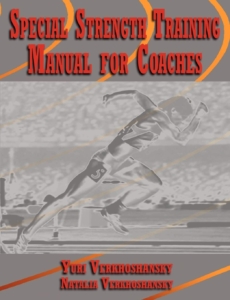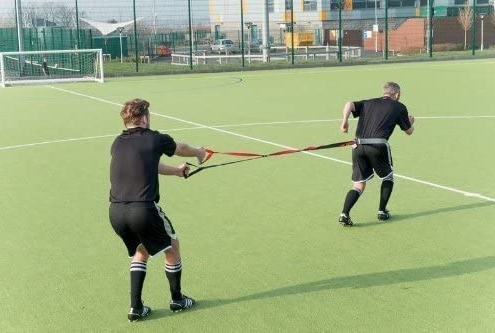Russian Special Strength Training (SST) – Part 3
This is the last blog post to round off my series on ”Power” development as it relates to jumping. There will definitely be a follow up on other concepts such as rotational power and upper body power, but I’ll save that for another day.
Special Strength Training Manual for Coaches – Vuri & Natalia Verkhoshansky (2011) has been a go to text for me over the years, and each time I read it I take another gem away. It’s certainly not an easy read, even with the good translation it’s still written in a pretty complex writing style so it can be hard to get through in parts.
In this Part 3 I will look at the remaining forms of combined methods of Special strength training (SST). Please take a look at Part 1 for more info on the Loading schemes recommended, and Part 2 for the first set of combined methods .
Combined Methods used in SST
The ultimate goal is to increase the level of maximal explosive force effort of similar movements using highly specific explosive strength exercises (jumps). Before the use of these highly specific explosive strength exercises, it is necessary to enforce the main muscle synergies (coordination), which ensure improvements in the CAPACITY TO OPPOSE THE FORCE OF GRAVITY: barbell squats, standing calf raises and more specifically, the seated calf raise.
Chapter 4 of the book features further information on the combined methods of SST which consist of combinations of different SST means in order to ensure a determined cumulative training effect. I will also refer back to Chapter 2 where Yuri talks about Isometric exercises (pg 81) and then gives examples of Combined Regimes (pg 83-85).
Depending on what means are used, how they are performed, and how they are temporarily combined, it is possible to differentiate the following Combined Methods:
- Complex Method
- Stimulation Method
- Contrast Method
- Circuit Method
- Strength-Aerobic Method
I will check back through the Triphasic Method book as I know that the use of the terms ”complexes” and ”contrasts” can mean different things to different coaches, but for the purposes of this blog the use of the word complex and contrast will be as used in the Book chapters, and according to their descriptions below.
For this blog I will focus on the final three : Contrast Method, Circuit Method and Strength-Aerobic Method.
Contrast Method
The Contrast Method is used mainly for increasing High-Speed strength (aka ballistic strength #APAMETHOD). This goal is achieved by creating a contrast of the kinesthetic sensations, performing, at maximum power output, a complex movement in alternating conditions, more or less difficult in comparison to the normal.
The physiological mechanism that explains how this works is based on ”motor engrams” which are the possible ways to accomplish a motor action stored and memorized in the brain. The higher the motor experience of the athlete, the more precise and unambiguous these instructions are. However, on the flip side, when the correct motor pattern has already been acquired, it’s difficult to obtain adjustments which could ensure a further improvement in the motor action.
If the athlete repetitively performs the same sport exercise, with the aim of executing it at the higher power output, their motor control system always uses the same engram. The kinesthetic sensations of the needed magnitude of force and speed of movement are FIXED IN THE BRAIN and become an ”archetype.”
Because of this archetype the athlete encounters great difficulty in changing the bio-dynamic structure of exercise when they repetitively strives to increase their power output. In addition, the same training stimuli, repeated consecutively, provokes a sensory adaptation and a desensitization (decrease in the sensitivity) of the nervous system to these stimuli, ceasing to produce the same training effect.
If the athlete executes the exercise with the same goal (maximal power output) but in DIFFERENT EXTERNAL CONDITIONS, the kinesthetic feedback adapts the motor structure to these conditions and the new motor engrams remains in the brain.
The new condition could be made MORE DIFFICULT when the athlete has a higher level of external resistance to overcome, or EASIER, when the level of resistance is less and the athlete can execute the movements with a higher speed.
Coaching application: the athlete performs the movement in the ”new” condition, and then immediately performs the ”normal” conditions, applying the new motor engram. This may allow the athlete to perform the exercise in the normal conditions with a higher force effort and/or with a higher speed.
There are many ways to vary the conditions of the competition exercise’s execution.
- Track & Field throwers – executing the final movement of the competition exercise or the competition exercises as a whole, with different weights of the sport device (using heavier and lighter weights to overload with a higher force effort and movement speed, respectively.
- Combat Sports – wrestlers use specific exercises performed with heavier or less heavy sacks (to imitate the opponent’s body) or with actual partners of higher or lower weights categories.
- Cyclic Sports – In a rower’s training a brake can be used to alternate between difficult and easier conditions. In a cyclist’s training, athletes alternate tracks with different speeds (on the road and on the track) and tracks (uphill/downhill) with different gears. In a swimmer’s training an elastic rope can be towed (see below), with 10-15 resisted strokes followed by short swim of 10-15 m under normal conditions, repeating 6-10 times. Track & field sprinters can execute over-speed running on a track of 30-40 m with a slight downward slope, followed by a flat run.
In field sports including Tennis creating more difficult or easier conditions is also a matter of experience and the power of imagination.
One common technique uses a quick release belt, which involves releasing the belt following a period of resistance from the partner who is being towed, or even a weighted sled.
Circuit Method
The Circuit Method is well known in sport practice. In this method the exercises, affecting different muscular groups, are carried out sequentially (circuit) and the sequence is repeated several times.
E.g., Shoulder press –> Back squat –> Hanging Leg raise –> Press-ups –> RDL –> Good mornings
The interval between exercises is usually of a short duration in order to execute the exercises of the training seance in an aerobic regime, think 60-sec on and 60-sec off. In this way both muscular system and cardiovascular system are stimulated. This method mainly helps to increase the capacity of the energy systems to perfect the functional capacities of various muscle groups.
VARIANT 1 – Eight stations of exercises are performed in which the work interval is 60 seconds and the rest interval is 60 seconds:
- Squats with 20 kg barbell
- Jumps in place
- Push ups
- Shoulder press
- Russian twists with 20 kg plate
- Jumps in place
- Power clean
- Shuttles
VARIANT 2 – Six stations of exercises are performed in which the work interval is 20 seconds and the rest interval is 10 seconds:
- Power cleans with 40 kg barbell
- Jumps in place
- Tricep extensions with 20 kg barbell
- Push jerk with 40 kg barbell
- Jumps onto a box 60 cm high
- Power snatch with 40 kg barbell
VARIANT 3 – Six stations of exercises are performed in which there is no rest between exercises and the rate of execution is maximal:
- Press ups – 20 reps
- Jumps over 10 low barriers
- Overhead med ball throws – 10 throws
- Leg scissors – 10 reps each side
- Single leg jumps over 10 low barriers – 2 reps on each leg
- Acrobatic exercise – 3 forward rolls
Strength-Aerobic Method
The main characteristic of the strength-aerobic method lies in the strength development of both the fast and the slow muscle fibres.
VARIANT 1 – is similar to the Complex Method. It includes two resistance exercises executed with the same muscle groups, but using different methods.
| Combinations Variant | First Exercise | Rest between exercises | Second Exercise | Number of sets of combination | Rest between sets |
| OPTION 1 | Barbell Squat
Weight = 80-90%
3 sets of 2-3 reps
Rest between sets 3-4 min |
2-4 min | Barbell Squat
Weight = 40-50%
3 sets of 15 reps
Rest between sets 2-4 min |
2-3 | 8-10 min |
| OPTION 2 | Barbell Squat
Weight = 80-90%
3 sets of 2-3 reps
Rest between sets 3-4 min |
2-4 min | Barbell Squat
Weight = 40-50%
3 sets of 15-20 seconds
Rest between sets 2-4 min |
2-3 | 8-10 min |
VARIANT 2 – is similar to the Circuit Method but includes more specific exercises executed in a more intensive interval regime, which further induces accentuated stimulation of the aerobic mechanism.
- The duration of the work is 20 minutes
- 8-10 specific resistance exercises
- Two consecutive exercises must NOT be executed by the same muscle groups.
- For each exercise the weight of overload is selected in such a way that permits execution of a set of 30-60 seconds duration without evident fatigue
- The rest between exercises is 1 minute.
- Heart rate during the work must not surpass 120-140 beats per minute.
- Squats with barbell
- Barbell bench press
- Sit ups
- Chest flyes with dumbbells
- Romanian deadlift with barbell
- Side bends with barbell
- Pullovers with barbell
- Barbell bicep curls
- Bent over row with barbell
- Overhead press with barbell
Hope you have found this article useful.
Remember:
- If you’re not subscribed yet, click here to get free email updates, so we can stay in touch.
- Share this post using the buttons on the top and bottom of the post. As one of this blog’s first readers, I’m not just hoping you’ll tell your friends about it. I’m counting on it.
- Leave a comment, telling me where you’re struggling and how I can help
Since you’re here…
…we have a small favor to ask. APA aim to bring you compelling content from the world of sports science and coaching. We are devoted to making athletes fitter, faster and stronger so they can excel in sport. Please take a moment to share the articles on social media, engage the authors with questions and comments below, and link to articles when appropriate if you have a blog or participate on forums of related topics. — APA TEAM







